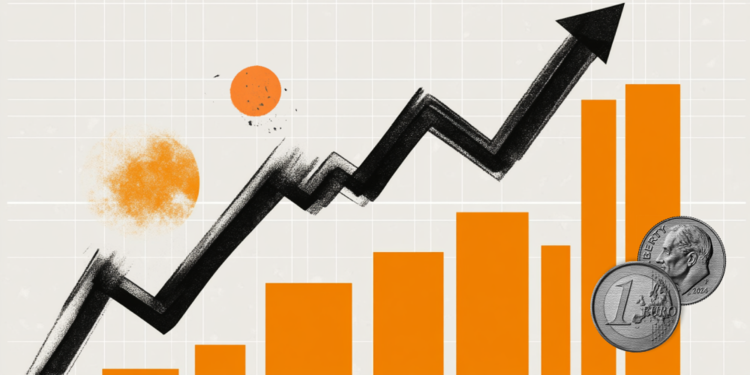EUR/USD stretched its weekly rally into a third consecutive day on Thursday and continued to push higher early Friday. After touching its strongest level in over a week near 1.1730, the pair corrected lower and was last seen fluctuating at around 1.1700.
Euro Price This week
The table below shows the percentage change of Euro (EUR) against listed major currencies this week. Euro was the strongest against the Australian Dollar.
| USD | EUR | GBP | JPY | CAD | AUD | NZD | CHF | |
|---|---|---|---|---|---|---|---|---|
| USD | -0.72% | -0.54% | -1.41% | 0.43% | 0.80% | 0.43% | -1.47% | |
| EUR | 0.72% | 0.18% | -0.63% | 1.14% | 1.62% | 1.16% | -0.77% | |
| GBP | 0.54% | -0.18% | -0.78% | 0.97% | 1.42% | 0.98% | -0.97% | |
| JPY | 1.41% | 0.63% | 0.78% | 1.79% | 2.18% | 1.88% | -0.13% | |
| CAD | -0.43% | -1.14% | -0.97% | -1.79% | 0.34% | 0.01% | -1.92% | |
| AUD | -0.80% | -1.62% | -1.42% | -2.18% | -0.34% | -0.44% | -2.36% | |
| NZD | -0.43% | -1.16% | -0.98% | -1.88% | -0.01% | 0.44% | -1.93% | |
| CHF | 1.47% | 0.77% | 0.97% | 0.13% | 1.92% | 2.36% | 1.93% |
The heat map shows percentage changes of major currencies against each other. The base currency is picked from the left column, while the quote currency is picked from the top row. For example, if you pick the Euro from the left column and move along the horizontal line to the US Dollar, the percentage change displayed in the box will represent EUR (base)/USD (quote).
The US Dollar (USD) failed to shake off the bearish pressure on Thursday and allowed EUR/USD to preserve its bullish momentum. In addition to the uncertainty surrounding the US-China relations and the US government shutdown, growing concerns over the unhealthy lending practices of regional US banks caused the USD to weaken against its peers.
Meanwhile, French Prime Minister Sébastien Lecornu has survived two votes of no confidence. Although Lecornu will face an uphill battle in a parliamentary debate to pass the budget until the end of the year, this development seems to be supporting the Euro.
Early Friday, US stock index futures trade deep in negative territory, losing more than 1%. The risk-averse market atmosphere seems to be limiting EUR/USD’s upside for now.
In the absence of high-impact data releases, the risk perception could drive EUR/USD’s action heading into the weekend.
However, the USD could struggle to attract safe-haven flows in case US Treasury bond yields continue to decline alongside stocks. On Thursday, the benchmark 10-year US T-bond yield lost more than 1% and dropped to its weakest level since early April below 4%. Another deep slide in US T-bond yields could open the door for another leg higher in EUR/USD.
EUR/USD Technical Analysis

After breaking above the 100-day Simple Moving Average (SMA), currently located at 1.1650, EUR/USD climbed above 1.1700, where the 20-day, 50-day and the 200-period on the -4-hour chart align. In case EUR/USD manages to stabilize above 1.1700 and confirm that level as support, 1.1765 (Fibonacci 23.6% retracement of the latest uptrend) could be seen as the next resistance level before 1.1820 (static level).
If EUR/USD retreats below 1.1700 and fails to reclaim this level, technical buyers could hesitate. In this scenario, 1.1650 (100-day SMA) aligns as the next support level ahead of 1.1580 (Fibonacci 61.8% retracement).
Euro FAQs
The Euro is the currency for the 19 European Union countries that belong to the Eurozone. It is the second most heavily traded currency in the world behind the US Dollar. In 2022, it accounted for 31% of all foreign exchange transactions, with an average daily turnover of over $2.2 trillion a day.
EUR/USD is the most heavily traded currency pair in the world, accounting for an estimated 30% off all transactions, followed by EUR/JPY (4%), EUR/GBP (3%) and EUR/AUD (2%).
The European Central Bank (ECB) in Frankfurt, Germany, is the reserve bank for the Eurozone. The ECB sets interest rates and manages monetary policy.
The ECB’s primary mandate is to maintain price stability, which means either controlling inflation or stimulating growth. Its primary tool is the raising or lowering of interest rates. Relatively high interest rates – or the expectation of higher rates – will usually benefit the Euro and vice versa.
The ECB Governing Council makes monetary policy decisions at meetings held eight times a year. Decisions are made by heads of the Eurozone national banks and six permanent members, including the President of the ECB, Christine Lagarde.
Eurozone inflation data, measured by the Harmonized Index of Consumer Prices (HICP), is an important econometric for the Euro. If inflation rises more than expected, especially if above the ECB’s 2% target, it obliges the ECB to raise interest rates to bring it back under control.
Relatively high interest rates compared to its counterparts will usually benefit the Euro, as it makes the region more attractive as a place for global investors to park their money.
Data releases gauge the health of the economy and can impact on the Euro. Indicators such as GDP, Manufacturing and Services PMIs, employment, and consumer sentiment surveys can all influence the direction of the single currency.
A strong economy is good for the Euro. Not only does it attract more foreign investment but it may encourage the ECB to put up interest rates, which will directly strengthen the Euro. Otherwise, if economic data is weak, the Euro is likely to fall.
Economic data for the four largest economies in the euro area (Germany, France, Italy and Spain) are especially significant, as they account for 75% of the Eurozone’s economy.
Another significant data release for the Euro is the Trade Balance. This indicator measures the difference between what a country earns from its exports and what it spends on imports over a given period.
If a country produces highly sought after exports then its currency will gain in value purely from the extra demand created from foreign buyers seeking to purchase these goods. Therefore, a positive net Trade Balance strengthens a currency and vice versa for a negative balance.







